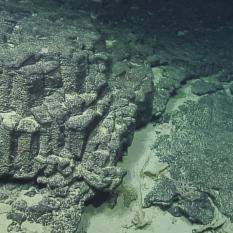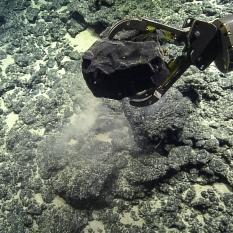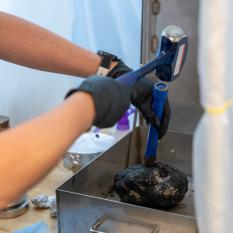A Tale As Old As Time: A Geologic Love Story
The “wow factor” of some dives on the Luʻuaeaāhikiikapapakū Expedition to Papahānaumokuākea Marine National Monument (PMNM) was impossible to miss. The team was treated to: huge, dense communities of corals and sponges, as well as charismatic creatures like angler fish, squat lobsters, and even a ghost shark. But for Dr. Andrea Balbas (https://www.csulb.edu/geological-sciences/page/andrea-balbas) and Dr. Beth Orcutt (https://www.bigelow.org/about/people/borcutt.html @DeepMicrobe on twitter), the drama and excitement of this mission was all about the rocks. They are trying to answer questions about the past volcanic activity that formed these seamounts and all that has happened in the 70-90 million years since.
Dr. Andrea Balbas loves a good story, and believes that rocks tell the best stories. That’s why she dates rocks. On the exploration, she was looking for large, angular volcanic rocks, a visual signal that they have not been altered in the 70-90 million years since the volcanic hotspot that formed these seamounts was active in the region. In the lab months and years after an expedition, she uses geochronological techniques to meticulously date the minerals that formed when the lava cooled. Figuring out the timing of volcanic eruptions can help answer important questions about pacing and orientation of tectonic plate movements through deep, geological time.
Dr. Beth Orcutt works at the intersection of geology, chemistry, and microbiology and is focused on what has happened to seafloor rocks in the millions of years since they were formed by cooling lava. In particular, she wants to zoom into the rind of mineral crusts that have formed on the lavas, where microscopic life resides. Although invisible to the naked eye, these microbes may play important roles in supporting healthy ecosystems in the deep ocean.
So what did Dr. Balbas and Dr. Orcutt see when they explored the seafloor on this expedition? Click through to learn more! After seeing rocks through the eyes of these scientists, you may find some “wow factor” of your own.
This expedition was sponsored by NOAA Ocean Exploration through the Ocean Exploration Cooperative Institute and NOAA Office of National Marine Sanctuaries. All images credited to Ocean Exploration Trust, NOAA Ocean Exploration, NOAA ONMS. This album was created by Science Communication Fellow Kim Weaver and photo editing by Science Communication Fellow Lindsay Holladay Van Damme.

Luʻuaeaahikiikapapakū - Ancient Volcanoes in Papahānaumokuākea Marine National Monument
Returning to Papahānaumokuākea Marine National Monument (PMNM) after an expedition in 2018, our team will be conducting ROV surveys on a chain of seamounts, and document whether these underwater mountains support vibrant coral and sponge communities like others in the region.
















